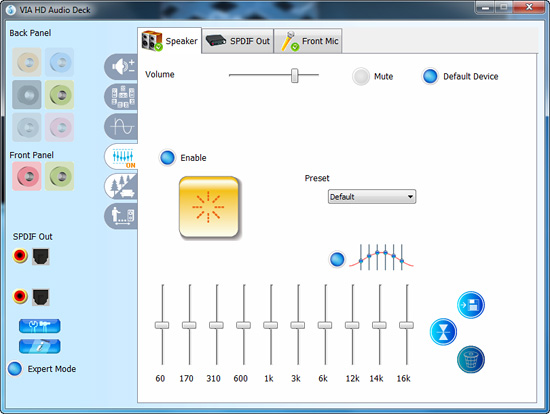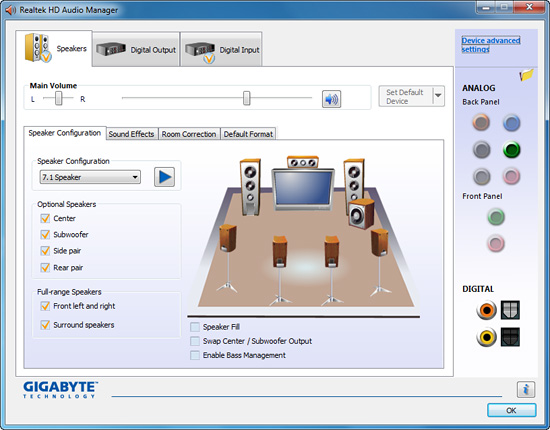Budget Micro-ATX P55 Faceoff: Gigabyte GA-P55M-UD2 and ASRock P55M Pro
by Gary Key on October 5, 2009 12:30 PM EST- Posted in
- Motherboards
Audio-
We are planning on taking an in-depth look at all of the current on-board audio codecs and compare them to a couple of discrete audio cards from ASUS and AuzenTech in the near future. In the meantime, we will provide a quick overview of the control panels from the two competing solutions today and a quick subjective analysis.

ASRock utilizes the VIA VT1708S 8-channel audio codec on the P55M Pro motherboard. To be honest, I had low expectations of this particular chipset. In actuality, it is a decent competitor to the Realtek ALC 888B utilized by Gigabyte. In fact, VIA has made great progress in their driver set and at this point I firmly believe the actual implementation by the motherboard manufacturer in regards to shielding is more important to audio quality than the any potential differences between the two chipsets.
That said, VIA has a very good control panel and option setup, certainly more so than Realtek in this particular case. The most beneficial item is the equalizer as you will need it for music playback. Midrange performance on this chipset is lacking depth and highs at times sound tinny. Both chipsets scored about even in Rightmark’s excellent Audio Analyzer software test suite with THD+ numbers slightly favoring the Realtek solution.
Unfortunately, my ears thought the difference in quality between the two solutions was a bit greater. The main problem with the VIA solution as implemented by ASRock was background noise that was directly attributable to electrical shielding problems on the board. In headphone mode, I could hear a slight background hum that would rise and fall with load activity on both the CPU and storage subsystems. It was very slight, but just enough to be noticeable in several classical and jazz soundtracks. It was also present in several games, mainly simulations and RTS games where there is not constant gunfire present in most first person shooters.

Gigabyte utilizes the Realtek ALC 888B 8-channel audio codec on the P55M Pro motherboard. Audio quality in music was better than the VIA VT1708S thanks to clearer midranges, but highs were still leaned on the tinny side and bass was even between the two chipsets.
Otherwise, I preferred the Via solution in games and movie playback, not by much, but channel separation was slightly better. Of course, if you really want better analog output a good discrete audio card is the solution. For most of us, either of the audio solutions will suffice, but thanks to the lack of background noise, we will have to give the Gigabyte board the win here.





















55 Comments
View All Comments
goinginstyle - Monday, October 5, 2009 - link
I loved the review also and it showed a lot of work went into testing these boards. I just wonder when TA152H is going to ruin this thread but until then it nice to see constructive posts. I also wish the mobo guys would just drop the floppy and IDE ports when possible. It would free up board real estate and hopefully drop the cost a little more.papapapapapapapababy - Monday, October 5, 2009 - link
not touching any of this at least it has Socket 775 mounting holesusb3 @ pci3 @sata6 and im there.
Docket - Monday, October 5, 2009 - link
It is a shame that there are no Linux versions of the Gigabyte software reviewed here... oh well maybe some day in a distant future.mitt - Monday, October 5, 2009 - link
Hallelujah! DPC latency benchmark in AnandTech reviews!mathew7 - Monday, October 5, 2009 - link
When MB manufacturers are going to let go of PCI?I recently switched to Micro-ATX, and found I have a real problem of choosing a motherboard.
I'm looking at buying a PCIe X-Fi, but would like to use a dual-slotted video card. But I would like to keep my options open for a second card (I'm htinking about physics, not SLI/CF, so dual-slot cooling is not required). While the Gigabyte does not pass my requirements, the Asrock also has a problem: usage of a dual-slot-cooled card inhibits the usage of the PCIex1 slot.
I intend to switch to i5/P55 at the start of next year, so I'm watching closely.
Jaybus - Thursday, October 8, 2009 - link
That will be a slow transition. There are still a lot of PCI adapters being sold out there, especially for some specialty markets like scientific instrumentation that take time to transition to new interfaces due to cost and low volume. Nevertheless, the demise of PCI is starting to happen. For most people it's not a big deal, because they only need 1 or 2 PCIe x16 slots for graphics cards and will never use the rest of the slots anyway.MadMan007 - Monday, October 5, 2009 - link
Kind of funny but Intel is leading the pack in that specific area, their $200 (ugh) 'Extreme' DP55SB mATX P55 mobo has no PCI slots, also no PS/2, IDE or floppy. Maybe it's consistent since they ditched PS/2 and other legacy connectors on some boards a while back. No telling on the overclocking front but it is an 'extreme' board so it may have at elast some overclocking features. It has a couple of neat features actually, Bluetooth and Intel NIC.Jaybus - Thursday, October 8, 2009 - link
And uATX is a good platform to remove PCI from. Why not drop it from uATX? They can always leave it on ATX boards for a while for those who absolutely need PCI slots. I think other manufacturers will follow that path very soon.MadMan007 - Monday, October 5, 2009 - link
*bzzt* The only PCIe 2.0 lanes on a P55 platform are from the CPU. So look carefully at specs and double check with companies when they say their secondary slots, especially ones that aren't even 16x mechanical, are PCIe 2.0. The UD2's 4x electrical slot in particular is clearly not according to Gigabyte, the ASRock claims to be but I'm not sure how if all 16 CPU PCIe 2.0 lanes are used for the graphics slot. If they used a lane splitter to provide PCIe 2.0 lanes to the other slots it kind of defeats the purpose, and if so it would be good to check performance with those slots populated.MadMan007 - Monday, October 5, 2009 - link
To follow up on this, the comment was based on the first few paragraphs. I looked over Intel's manual for their 'extreme' mATX board for my post about it and Intel actually states their mobo has PCIe 2.0 lanes to the additional PCIe slots. Not surprising for the 8x slot I guess but it is for the 1x slots and it seems unlikely Intel would misquote specs.On a related note there is one thing I've not seen yet from any review and that is how PCIe lanes get assigned, mainly to the primary 16x slot, when populating a secondary PCIe slot with a 1x or 4x card. Do the lane splitter chips assign 8x lanes to a secondary slot which has a 1x or 4x card or what? Not a huge deal but it's a little thing that would be nice to know.